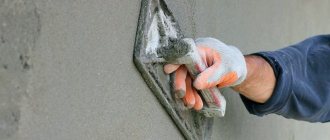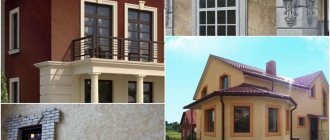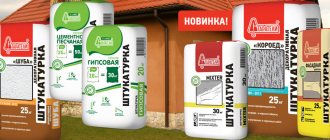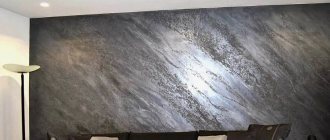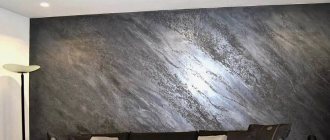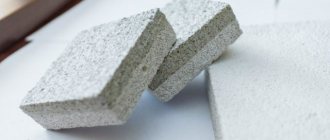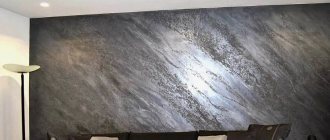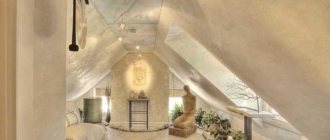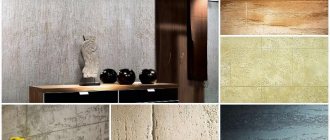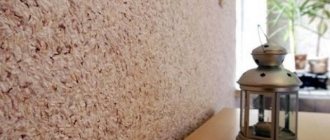Gypsum has been known as a building material since Sumerian times. Gypsum structures erected in the Middle Ages have a strength close to that of concrete. It turns out that grains of crushed and rounded natural gypsum were used as a filler, and construction solutions were mixed with a minimum amount of water - the water-gypsum ratio was less than 0.4 (modern ~ 0.67). Modern gypsum plaster is an excellent finishing material that can be used for finishing and decorating your home. The question of which plaster to choose for leveling walls is not an idle one. You can learn more about gypsum-based plaster mixtures from this article.
Characteristics and composition
The name "gypsum plaster" is not entirely accurate. Gypsum is a mineral from the sulfate class. It has a double structure: fibrous - selenite, granular - alabaster. It is from alabaster that the plaster mortar is obtained, which everyone knows as gypsum.
The technological process is not very complicated:
- the mineral is fired at high temperatures for a long time;
- crushed to a powder state - the smaller the particle fraction, the higher the plasticity and better binding properties;
- additives are introduced:
- fillers with granules no more than 1.5 mm - reduce the weight of the solution. For these purposes, the smallest particles of polystyrene foam, foam glass, vermiculite, and perlite are used;
- plasticizers and modifiers - reduce the speed of setting of alabaster (without additives, after 5 minutes the mixture becomes stone) and improve the level of adhesion.
- bleaches - lime (used before), titanium or zinc based white;
- polymer additives - increase the viscosity and strength of dried plaster.
Available for sale in bags of 5, 15, 25 and 30 kg.
Crushed alabaster.
This is the composition of the dry mixture. Water and retarding agents are added to the ready-to-use paste, as a result of which the solution does not harden without access to air. Pasta is sold in plastic buckets.
Technical characteristics depend on the density of the material and the size of the component fractions. Therefore, specific numbers may vary. The main indicators are:
- color - can be white, gray with different shades, pink and beige;
- The proportion of water for mixing is on average 2:1, where 2 is gypsum, 1 is water. But different manufacturers have deviations - from 0.4 l per 1 kg of mixture to 0.6 l / kg. You need to look at the recommendations on the packaging;
- the thickness of the base layer without reinforcement is from 2 to 5 cm (different for each manufacturer);
- compressive strength - 25-40 kg/cm2 (according to GOST 31377-2008 - 2.45 MPa);
- work is allowed at a temperature of - +5-+30oC;
- solution lifetime - 1 hour (according to GOST - 45 minutes for manual laying, 90 - machine);
- complete drying time - 3-7 days (depending on the thickness of the layer);
- composition consumption per 1 mm of layer - 0.8-1.2 kg/m2 (hand laying - 0.85-1.0 kg/m2, machine - 0.75-0.9 kg/m2;
- adhesion force to the base - 0.3 MPa;
- moisture retention without dripping - 90%. Solutions with 95% appeared on sale, which is much better;
- density - 950 kg/m3;
- vapor permeability - 0.11-0.14 mg/ (m*h*Pa);
- shrinkage of the base layer is not allowed.
Gypsum plasticizers
Plasticizers are substances that regulate the crystallization processes of gypsum with different chemical bases. They are added for:
- increasing the strength of the solution (by reducing the water absorbed by gypsum; the harder the gypsum is, the less water is used);
- increased fluidity;
- ensuring waterproofing and good shrinkage;
- reducing the freezing point of water;
- acceleration of hardening in cool conditions;
- increasing adhesiveness;
- increasing air permeability and water resistance.
The concentration of the plasticizer can regulate the setting time.
Some of the popular brands are: Fluid Premia 325, Vianplast, Sika ViscoCrete-G2, Friplast.
Concrete plasticizers are not suitable for gypsum. Unlike white (for gypsum), they have different colors (brown, yellow, gray).
Pros and cons of gypsum plaster
Gypsum plaster has gained popularity due to its advantages :
- high plasticity - easily applied and stretched in a thin layer onto horizontal and vertical building structures;
- good adhesion to almost all building materials, including concrete, brick, aerated concrete and clay bases;
- formation of a smooth surface after drying - no further processing is required: grouting and sanding with finishing mixtures;
- absence of shrinkage with a plaster layer of up to 3 cm, and, therefore, the entire surface - no microcracks form;
- excellent soundproofing properties - absorbs indoor noise, weakens structural noise;
- prevents heat loss due to the low thermal conductivity coefficient - 0.23-0.3 W/m*K;
- low weight - no serious loads are created on the walls and foundation;
- environmentally friendly - sanitary standards allow use in any room of a house or apartment (children's room, bedroom);
- ability to pass vapor molecules (vapor permeability). Thanks to this, a comfortable microclimate is maintained in the plastered room;
- economical consumption - allows you to completely offset the higher price compared to CPR;
- fast setting - the following stages of the technological process are not delayed;
- short drying period - from 3 to 7 days, which significantly reduces repair time;
- does not serve as a basis for the development of fungi and mold;
- thinner base layer than cement mortars - 2 cm versus 3 cm;
- fire safety - fire-resistant partitions are manufactured.
The list of strengths is impressive. However, the existing disadvantages narrow, however significantly, the scope of application:
- afraid of moisture - cannot be used outside (on facades) and in rooms with high humidity (basement, bathroom, open balcony or loggia, etc.);
- having an acidic environment, it corrodes metal, even galvanized;
- has low surface hardness - can easily chip or leave a deep scratch;
- Quick setting for beginners in plastering creates problems: they do not have time to work out the batch. But this is the other side of the coin, because... for professionals this is an undoubted advantage;
- Do not work in unheated rooms in winter. Only at positive temperatures - from +5oC or more.
Varieties
Bark beetle
The main parameters of such decorative gypsum plaster:
- Polymer and mineral additives. With them, the material becomes lighter, and this reduces the load on the wall.
- No toxic substances, contains only environmentally friendly components. You can not be afraid to apply this mixture in bedrooms and rooms with high humidity.
- Fire resistance. Withstands temperature changes ranging from -55 to 60 degrees. It does not fade in the sun and does not lose its original appearance.
- Resistance to mechanical stress. Can be safely cleaned with sponges or a vacuum cleaner.
- Ideal color for painting. The basic shade of the bark beetle is white. But white is easy to dye.
Advice
Depending on the direction of movement of the brush along the base, you can get a drawing. Movement along or across creates different patterns. With the right approach, changing the direction of the brush, you can get beautiful wall masterpieces.
“Bark beetle” is not suitable for sealing defects, cavities, and cracks. It is sold in the form of a ready-made mixture or a dry concentrate, which must be diluted with water according to the instructions. The main indicator of the mixture is the grain size: the higher it is, the greater the consumption.
Fur coat
The surface texture of “fur coat” strongly resembles sheepskin turned inside out and slightly crushed. It differs in composition and method of application:
- Mineral. The composition contains binder lime, cement and sand. To improve the properties, plastic, fire-resistant substances are added. In many cases, you can find additional elements that prevent rotting and make the composition resistant to sunlight.
Important“Fur coat” made from mineral mixtures is environmentally friendly, insensitive to fire, and frost-resistant. The only drawback is the high susceptibility to cracks at the slightest mechanical impact on it.
- Acrylic. Synthetic acrylic resins give elasticity to the “fur coat”.
It can be used in rooms where there is a seismic threat or houses are located near railway tracks. To prevent the formation of fungal infections on the wall surface, bactericidal substances are added to the compositions. Acrylic gypsum plaster consists of polymers that are susceptible to fire. Therefore, you should not place the finish close to the fire source. - Silicone. The main substance that imparts viscosity is polymer resins. This is the most elastic and durable finish, suitable for facade work; it costs many times more than mineral and acrylic.
All the advantages of the “fur coat” are the same as those of the “bark beetle”. The only drawback is the ability to accumulate dust. Such coatings require regular wet cleaning.
Kameshkovaya
Pebble gypsum mixture is made from synthetic binders. It has increased plasticity and elasticity. Cracks, deformations, and breaks are not typical for it. There are acrylic, silicate and combined mixtures. Depending on the filling there are:
- marble;
- granite;
- artificial.
The structure of the coating is created by the size of the stones.
Advice
The mixture is applied to the wall only at positive temperatures during the first hour after mixing. To improve the adhesion of the material to the wall, it is necessary to prime the base at least 2 times.
- There is a cement-based pebble mixture with binder polymer components, which is sold in powder form. This material does not contain dyes in its composition.
- There are also acrylic mixtures. They are high quality, easy to apply, and stick to any surface.
- Silicate pebble gypsum mixtures basically contain liquid glass. Thanks to this content, this plaster dries quickly, is waterproof, durable, and antistatic. Apply to aerated concrete surfaces.
- If we talk about silicone plaster, then it contains synthetic rubber and silicone resins. It adheres well to any type of surface, has water-repellent, antifungal, and bactericidal properties. This is the most expensive type of pebble plaster with the longest service life after application.
Application area
Alabaster-based plaster was originally intended for plastering walls and ceilings inside residential premises made of any materials: concrete, brick, aerated concrete, plasterboard, etc. under wallpaper and paint. Later, they began to putty on slopes, use it to seal seams between sheets of drywall, and with the advent of fiberglass reinforcement, to strengthen the joints of concrete ceilings.
You cannot plaster metal, facades, walls and ceilings in damp and damp areas. There are two reasons:
- acidic environment corrodes metal structures;
- At high humidity, gypsum plaster actively absorbs water vapor, softens and floats or collapses.
But there are exceptions here too. So, gypsum plaster is used under tiles in the bathroom, but not under wallpaper or painting. Gypsum mixtures also appeared for facades. But the amount of polymer additives there is so large that it is not correct to talk about gypsum solutions. These are rather gypsum-polymer plasters.
Making your own gypsum mortar
Gypsum solution is also used in its pure form. Castings are made from it for wall decoration. To prepare a simple solution, pour cold water into a clean container and add gypsum powder, scattering it over the surface of the water. The powder is added until a small mound grows above the water. Kneading is done with a spatula. You can try stirring with your hands to feel what processes are happening. A slight heating of the mixed mixture indicates the readiness of the solution.
Types of gypsum plaster
The criteria for classifying plaster by type are:
- size of component fractions;
- method of application;
- appointment;
- release form;
- color.
Fraction size
When doing plastering work with your own hands, it is important to select the correct mixture according to the particle size of the components. After all, the purpose of the solution depends on the fraction:
- coarse-grained - intended for thick layers of plaster (5-8 cm) when eliminating large surface defects. Difficult to find on sale. You definitely need a reinforcing mesh - without it it will shrink and crack;
- medium-grained is the most popular type of dry mortar. Used to level small differences in height, up to 3 cm. The maximum possible layer thickness is 5 cm, but from individual manufacturers;
- fine-grained - applied with a thickness of no more than 8 mm onto existing layers of previous types. With a thicker layer, extensive cracking is possible. Can be used for putty for painting.
Application method
You can plaster walls in different ways:
- manual - used in small areas or when performing work independently;
- machine - the solution is quickly applied to the walls. The quality of the dried surface is almost perfect. However, to mechanize the process of leveling walls, a stirring station and a pneumatic blower are needed. The equipment is expensive, which is why the prices are high. They can be reduced to an acceptable level only by increasing the volume of work.
Purpose
According to their intended purpose, solutions can be:
- starting ones - applied directly to the walls, hiding defects;
- finishing - laid on an existing layer of plaster. The only function is to make the surface smooth to a mirror shine;
- universal - can be used for any purpose.
Attention: finishing solutions can be applied to drywall without an underlying layer of coarse or medium-grained mixtures.
Release form
Gypsum solutions are offered for sale in the form of:
- dry mixes - sold in bags;
Dry mixture.
- pastes - ready-to-use solution. Packaged in plastic buckets. Weight can be from 1 to 18 kg.
Paste.
Color
Gypsum plaster is associated with the color white. However, you can find dry mixtures on sale:
- white;
- gray, with different shades;
- beige;
- pink.
Colored gypsum mixture.
Application methods
Gypsum decorative plaster can be applied in two ways:
- Manual. Dilute the solution in a container, throw it onto the base with a trowel, starting from the bottom and moving up. The lower layers should be thicker than the subsequent ones. Using the Rule, each section should be leveled in the same direction with an oscillating movement from side to side.
- Using a spatula, they are straightened and all defects are repaired (strokes, chips, protrusions visible after repair).
- Then, using a trapezoidal rule, marks and irregularities are trimmed.
- It is necessary to periodically run a spatula over the previously laid plaster from the bottom up to avoid sagging.
- Machine. The special device consists of a container for the solution, a hose with a gun in the form of a nozzle, a compressor, a power cable and a control panel.
Buying such a complex for one time is unprofitable and expensive. You can rent a car or invite professional finishers. The finished mixture is placed in a container and supplied under pressure through a hose from the control panel. The correct position of the gun when spraying the mixture is 3 cm from the wall. The layers should overlap each other. At the last stage, the surface is rubbed manually.
Recommendations for selection
The quality of repair depends on the materials. When choosing gypsum plaster, you must first pay attention to the technical characteristics . They must comply with GOST (given at the beginning of the article). If there are deviations, and they occur in imported products, you need to analyze what consequences this will lead to.
For example, with a manual application of plaster consumption of 12 kg/m2 per 1 cm layer, the cost of finishing increases sharply. In this case, you need to look at the price and the presence of unique properties - the low cost compensates for the overexpenditure, and moisture resistance or high strength will allow you to plaster the walls in the bathroom or kitchen.
The second indicator that you should pay attention to is the date of manufacture . As a rule, the shelf life of mixtures is 6 months. After it expires, problems arise with stirring - many lumps form inside the bag, which are difficult to dissolve. True, the quality characteristics remain virtually unchanged.
The container must be undamaged - gypsum actively absorbs moisture from the air. The result is lumps that practically do not grind. It is better not to buy such dry plaster. Two more important indicators:
- drying time. Varies from 3 to 7 days. More flexible solutions dry faster;
- viscosity. The more plastic the mass, the more convenient it is to work. But such mixtures also have increased consumption. More consumption means higher repair costs. You need to choose one thing.
For wet rooms you need to buy moisture-resistant brands of gypsum plaster. But for financial reasons, it is better to use a well-tested technology - cement-sand mortar for interior work.
If you want to reduce the cost of materials, you can buy alabaster (sometimes they write gypsum on the packaging, which is the same thing). Rapid setting can be eliminated using diluted PVA glue (1% of the solution volume), slaked lime, citric or tartaric acid, or even better by adding the retarder “Plast Retard PE”. In any case, it will be cheaper than dry mixture or paste.
And, of course, look at the manufacturer - for time-tested brands, all the strengths and weaknesses can be found on various forums. Here, buying a “pig in a poke” is excluded.
Popular manufacturers
Many companies produce gypsum plaster. But in terms of popularity, not a single product can compare “Knauf” Rotband (“Knauf” Rotband) Indeed, high plasticity, an easy-to-work consistency, which is why the mortar adheres well and adheres well, the absence of shrinkage and, as a result, a surface without cracks after drying, are liked by builders.
But there is one big drawback: the price is greatly inflated. At the same time, not due to the best quality and operational characteristics - they are approximately the same for all leading ones, “DeLuxe”, “Unis”, “Ceresit”, etc.), but due to the promoted brand.
Among the competitors, there are several companies that are really good in terms of product quality.
"Volma". The Russian manufacturer supplies the following line of mixtures to the retail chain:
- “Layer”, “Plast”, “Canvas” - for classic manual application;
- "Gypsum asset" - for mechanized.
The product is intended for leveling walls, restoration and decorative work. Peculiarities:
- low price;
- good adhesion to all types of wall materials;
- insufficiently high ductility;
- does not like significant changes in temperature and humidity;
- maximum thickness of one layer - 3 cm;
- no shrinkage during drying;
- does not peel off or crack;
- the color is not only white, but also beige or pink;
- It sets faster than the stated 45 minutes, which creates problems, especially for home craftsmen.
The company guarantees high performance characteristics of the plaster with a layer thickness of up to 5 cm, but subject to reinforcement with fiberglass or basalt mesh.
"Prospectors". Another domestic manufacturer. Supplies mixtures for interior work to the building materials market. They can be used for finishing walls and ceilings, sealing seams and joints, and restoring stucco.
There are no complaints about product quality. It is plastic, fits well, and glosses easily. Plus, the maximum permissible thickness of the base layer is large - up to 5 cm. The disadvantage lies in the area of logistics - packaging in bags of 15 and 30 kg, which is not always profitable.
"Unis". The Russian one has several enterprises in the country. It produces products with the following technical and operational parameters:
- White color;
- diluted in a ratio of 0.4-0.5 l / kg;
- base layer thickness - 5-50 mm;
- compressive strength - 2.45 MPa;
- plasticity is maintained at temperatures from +5 to +30°C;
- the life activity of the solution is 50 minutes;
- consumption per 1 cm of layer - 8-9 kg/m2.
Reviews vary widely in quality. At some enterprises, control over compliance with the technological process has been established. As a result, there are no complaints. At the same time, where this point is missed, shortcomings are noted:
- does not mix well - lumps remain;
- slides off the walls, despite experiments with the amount of water;
- takes a long time to dry.
Can be applied manually or by machine.
"Ceresit". The German company, under the trademark “Ceresit”, produces in the Urals (Chelyabinsk) not only gypsum plaster, but also gypsum-polymer plaster for facade work.
The plaster mixture is impact-resistant, plastic, with an optimal consistency, which allows you to apply different patterns using rollers - imitation of some types of decorative plaster. The disadvantage is the price. Too high. But you have to pay for quality and brand.
"Deluxe" Plaster mortars are not inferior in quality and technical characteristics to German manufacturers, but at a lower price.
"Bolars." The product is used for leveling walls and ceilings. It has:
- color - white or gray;
- compressive strength – 2.45 MPa;
- consumption for a layer 1 cm thick - 10 kg/m2;
- solution lifetime - 60 minutes.
Mixes easily. Lay in a layer of 2 to 30 mm. If the solution thickens ahead of time, you need to re-stir without adding water. Among the disadvantages, consumers note the high price - the most expensive plaster among domestic manufacturers.
Types of plaster gypsum mixtures
Plaster compositions with gypsum are varied. They are divided according to several parameters.
All of them are divided by area of application into:
- universal gypsum plasters;
- gypsum plasters for exterior use (new mixtures with special additives used outdoors);
- gypsum plasters for interior work.
According to operating conditions:
- for dry and normal rooms;
- for rooms where the humidity level periodically increases, but not higher than 75% (subject to a waterproofing coating).
By place of use:
- universal (wall and ceiling);
- high-strength (for floor screeds);
- only for walls (vertical surfaces).
By purpose of use:
- Rough for the base layer. The base compositions contain coarse sand, so they can be applied in a thicker layer. This coating can also be used under decorative plaster for interior decoration, for example, Venetian or Moroccan plaster, facing work.
- Finishing or finishing. Filler grain up to 0.63 mm allows you to obtain a smooth (glossy) surface with a minimum layer of 2 mm.
There are also:
- hand applied gypsum plaster;
- SGShS for mechanized plastering of walls.
According to composition (content of main components) they are distinguished:
- dry gypsum plaster mixtures (SGSHS);
- gypsum-polymer SS (dry mixtures), for example, GYPSOPOLIMERtm, (with polymer additives that ensure good adhesion of gypsum to any base);
- gypsum polymer putties;
- gypsum self-leveling SS for screeds;
- lime-gypsum plaster mixtures;
- gypsum putty.
They all have their own areas of application, pros and cons, as well as characteristics.
Materials and tools
To work with gypsum dry plasters you need to have:
- dry mixture;
- primer;
- reinforcing mesh made of fiberglass, basalt or plastic;
- metal profile for beacons;
- self-tapping screws;
- special clamps for attaching beacons: “Kremmer”, “Ushastik” or clips. What they are and how to use them can be found here.
Tools and equipment needed:
- stepladder or strong table;
- container for mixing the solution - a 10 or 12 liter bucket;
- electric drill or powerful screwdriver with different attachments (mixer, drill and cross-shaped bit);
- grinder or metal scissors;
- trowel (trowel) for applying mortar to the wall;
- h-shaped rule - for leveling and redistributing the solution;
H-shape rule.
- trapezoidal rule for pruning;
- spatula, even better two: wide and narrow. The first is used for polishing the solution and instead of the falcon, the solution is collected, the second is for processing hard-to-reach places;
- primer cuvette;
- roller or mat - walls are primed;
- sponge grater for polishing the surface. You can take P400 sandpaper and wrap the block;
- laser level or building level;
- roulette;
- plumb line;
- fishing line or twine for hanging walls;
- simple pencil.
Calculation of plaster consumption
The consumption of gypsum plaster per 1 m2 is influenced by several factors:
- curvature of the walls - the greater the slope or height difference, the thicker the layer of plaster is needed;
- type of mixture - grinding depth and consistency affect technological consumption rates. Indicated on the packaging;
- manufacturer - the plasticity of the solution depends on the additives added. But this is a double-edged sword: convenient application equals increased consumption, for which you have to pay.
Master plasterers use several calculation methods to calculate the amount of dry mixture. More accurate results can be obtained after installing the beacons. To do this, design points are marked vertically and horizontally at equal distances from each other on the wall surface. Experts call them key. The more there are, the more accurately the required volume of the mixture is determined.
Then, at each point, the distance from the wall to the conditional plane, which is formed by the beacons, is measured. The resulting numbers are added and divided by the number of measurements. The result is an average layer thickness. Then everything is simpler. The area of the surface to be plastered is found (window and door openings are subtracted from the area of the wall), the consumption rate is taken and the amount of dry plaster in kg is calculated. The formula looks like:
V = S x T x N x k , where:
- V is the volume of dry gypsum mixture, kg;
- S—wall area for plastering, m2;
- T—thickness of the plaster layer, cm;
- N—consumption rate for a layer of plaster 1 cm thick, kg/m2;
- k is the coefficient of unaccounted losses. For professionals it is around 5%; home craftsmen need to target an overrun of around 10-15%.
The procedure ends with determining the number of bags. To do this, the result obtained when calculating using the formula is divided by the weight of the bag and rounded up.
What it is?
Gypsum is calcined gypsum stone that is ground into a powder.
Important
The environmentally friendly natural material lies in a thick layer on the surface of the walls and hides existing visible defects well.
Gypsum plaster contains a large percentage of this material and various additives. They are necessary so that the mass does not harden on the surface too quickly and it would be possible to apply the finishing coat and make a drawing without rushing.
Gypsum decorative plaster, in addition to the main component, contains:
- Fine fillers. They lighten the weight of the building mixture. The most commonly added materials are expanded polystyrene, foam glass and perlite.
- Plasticizers that increase elasticity.
- Whitening particles. Lime or similar materials may be added.
- Retarders.
Thanks to fillers, thermal insulation properties are increased and adhesion is enhanced.
This gypsum plaster can easily be applied to any type of surface . This:
- brickwork;
- concrete walls;
- glossy surface;
- expanded clay concrete;
- aerated concrete;
- cellular foam concrete.
- horizontal or vertical - before finishing It can be used to form walls and ceilings, but in conditions of normal humidity. Recommended to be used for sealing:
- pits;
- cracks;
- cracks.
Suitable for residential/non-residential premises. But only interior finishing needs to be done.
Preparatory work
You need to start leveling the walls by preparing the surface for applying plaster. During the work, the following tasks are solved:
- the strength of the walls increases;
- the level of moisture absorption from the solution by wall materials is reduced;
- adhesion between the base and plaster improves.
The process consists of several independent stages:
- wall repair;
- applying primer;
- installation of beacons;
- mixing the solution.
Repair
At the first stage of preparatory work, the strength of the plastered surfaces is restored. For this:
- Electrical wiring, wall lights, sockets, switches, etc. are removed from the wall. The surface must be cleared of anything that interferes with further work;
- The furniture is moved to the center of the room. If necessary, covered with plastic film;
- old finishing is removed;
- if there is a large area of “bubbling” plaster, it will be completely knocked off;
- cracks, chips, cracks are repaired;
- Contaminants are removed: dust, dirt, greasy heels, traces of paint.
Unfortunately, the length of the article does not allow us to consider this stage of preparatory work in more detail. You can find out more details in the material “How to prepare walls for plaster?”
Primer
Concrete and brick walls actively take water away from any solutions, disturbing the water balance. There is no need to explain what this leads to. Therefore, surface waterproofing is necessary. This can be done using a primer, which not only prevents unauthorized removal of moisture, but also improves the adhesion of the solution to the base.
You need to prime it 2 times, and preferably aerated concrete three times. The next layer is applied to the completely dry previous one. On a flat surface, 1-6 hours are enough for complete drying, on a porous surface - 6-12 hours.
For all types of concrete, it is recommended to use “Betonokontakt”; for other surfaces, other types of primer: acrylic or styrene-acrylate deep penetration primers are cheaper.
Attention: concrete and brick are also primed twice until they are saturated with moisture. But here it is allowed to use a diluted primer for the first layer.
Important! In many works devoted to the problems of gypsum plaster, it is recommended to reinforce the walls after applying the primer. This cannot be done for two reasons:
- Only metal fittings are attached to the wall. But metal and gypsum mortar are incompatible - the reinforcement is corroded by the acidic environment of the plaster within 5-7 years. The option is no longer available;
- Fiberglass mesh is ideal. But it is not attached directly to the surface, but is pressed into the already applied solution and covered with a thin layer of gypsum. More detailed information about reinforcing mesh and fastening methods can be found here.
Reinforcement with fiberglass mesh.
Use in damp rooms and outdoors
It is a mistaken belief that plaster finishing in toilet rooms is unacceptable. However, toilet rooms are classified as rooms with short-term high humidity. Therefore, GShS is not only possible, but also desirable to use in them. The only condition is that waterproofing is installed in places where there is direct contact with water. In shower rooms, waterproofing is done completely. Waterproofing is selected that is suitable for application to a gypsum base.
A deep penetration primer applied in 3-4 layers is often used as waterproofing.
It was believed that gypsum mortar should not be used to plaster facades where there is constant rain and large temperature changes. New SGShS compositions (gypsum-mineral and gypsum-polymer) are used for outdoor work. Gypsum-polymer compositions are even used for silicate-brick masonry, as well as for a thin layer that levels concrete. Polymer modifiers increase the frost resistance and strength of the coating. In gypsum-mineral compositions, mineral plasticizers are used, which are additional binders.
Installation of beacons
Beacons are installed when the thickness of the plaster layer is more than 10 mm. The process is complex. Requires a detailed description of each action. Therefore, we refer everyone who is interested in technology to the relevant material, which can be viewed here.
Lighthouses on mortar piles.
Let us note only one nuance that needs to be taken into account. When reinforcing the solution, the beacons are installed only on self-tapping screws. If you do not plan to use reinforcement, you can use mortar piles.
Mixing the solution
When mixing the solution, you need to follow a few simple rules:
- the mixing container must be clean;
- the mixture is poured into the water, and not vice versa;
- mandatory adherence to the proportions recommended by the manufacturer (available on the packaging). Deviation disrupts ductility, drying time and, as a result, leads to shrinkage with cracking of the surface;
- the plaster removed according to the rule is dumped back into the solution and mixed;
- Before each subsequent batch, the dishes and tools are washed well. Otherwise, the next batch will set faster. Or there may be lumps.
The instructions on how to thin gypsum plaster are simple:
- 1 liter of water at room temperature (20-25oC) is poured into a clean bucket or basin;
- pour out the amount of dry mixture in accordance with the recommendations;
- Using a power tool with a mixing attachment, the solution is kneaded until a homogeneous consistency is obtained for 2-3 minutes. You can stir by hand, which is more difficult and takes longer;
- the solution is infused for 5-7 minutes. Some manufacturers indicate 2-3 minutes;
- mix again until a creamy consistency without lumps is obtained.
The readiness is checked with a trowel - the solution should not drain from the plastering tool. For putty - slowly slide off the trowel tilted at an angle of 45o.
Plaster plaster mortar can be prepared independently from pure gypsum. Several recipes from professionals will help with this.
Recipe No. 1. Take 4 parts of alabaster (gypsum) without additives and mix with sawdust (1 part) and ceramic glue (1 part). All this is thoroughly mixed and then diluted according to the technology described above.
The process takes place in two stages - the solution must mature for 3-4 minutes (it gains strength and plasticity), after which it is stirred again. You can slow down the setting process with PVA glue (1% by weight of the solution) or citric acid (tartaric acid is also allowed, but it is more difficult to find on sale). You need 0.05-0.15% dry citric acid powder by weight of gypsum
Recipe No. 2. Mix 1 part gypsum with 3 parts ground chalk. Add 5% of the resulting mass of wood glue and mix again. Dilution and introduction of retarders, as in the first recipe.
Recipe No. 3. Lime dough is being prepared. Gypsum is mixed in the same proportion, after which the compositions are mixed.
How long will it take to dry?
To continue finishing work, you need to know not only how long it takes for gypsum plaster to dry, but also at what speed it gains strength. After all, the finishing touches: gluing and painting can begin after the plaster has completely hardened. This takes from 3 to 7 days, depending on the thickness of the layer. But it’s better not to risk it and start the next stage of repairs in a week. But the applied solution dries within 1-2 days.
The process of strengthening should take place under natural conditions at a temperature of +5-+25°C. No heat guns, heating devices operating nearby, or drafts.
Checking the moisture content of the plaster.
Before subsequent finishing, the room is ventilated and the plaster is primed. The surface ready for wallpaper or paint should be smooth and light. Humidity for wallpaper should not exceed 4-5%, for paint - 1%. Drying up to 10 days may be required to achieve this moisture content.
Surface preparation
Before you start plastering the walls, you need to properly prepare the surface of the walls. They should be:
- dry;
- cleaned;
- even.
Otherwise, the adhesion of the plaster to the wall will be weakened, which may lead to peeling in the future, and the applied layer will not have optimal smoothness and durability, which will lead to the need to make repairs again.
For the reasons stated above, it is necessary to carefully remove from the walls that we plan to plaster all dust, dirt and remnants of wallpaper, paints and other traces of previously applied coatings. For this purpose, use a coarse brush with thick bristles. All types of abrasive paper will be useful, and in the case of large raised debris that cannot be removed using traditional methods, a sander will also come in handy.
When the surface is cleaned, the next step is to prime it. The primer can be applied with a brush or roller. If you need to do everything faster, it is recommended to use a painting block.
The type of primer depends on the type of surface:
- For smooth, low-absorbing and compact wall surfaces, an adhesive primer, such as adhesives, would be a good solution. Works well with concrete substrate;
- Porous surfaces with high absorbency - in this case leveling and adhesive primers should be used. They are ideal for walls made of cellular concrete or ceramic bricks.
Before starting work, you should also carefully protect all corners of the walls. To do this, you can use special protective profiles made of stainless steel. If we know that some parts of the surface are particularly susceptible to cracking, it is worth applying a plaster mesh to them.
Plaster patches may also be helpful. They are indispensable when we decorate rooms with a large area, and wherever we will lay ceramic tiles at the next stage. They make it easier to apply the plaster and lay the ground, so we can be sure that the plaster will have the same thickness everywhere on the wall.
Recommendations for subsequent finishing
On gypsum plaster it is allowed to glue wallpaper, apply liquid trellises and cement-based decorative solutions, and paint. At the same time, you need to remember that for decorative finishing based on CPR you need to apply a primer twice. Paint can be of different types. But whitewashing with lime mortar is excluded. Even with a primer.
Instead of a conclusion. There are no bad gypsum based plasters. The finishing can be done independently with excellent quality, if you take into account the characteristics of the solution and the nuances of working with it.
